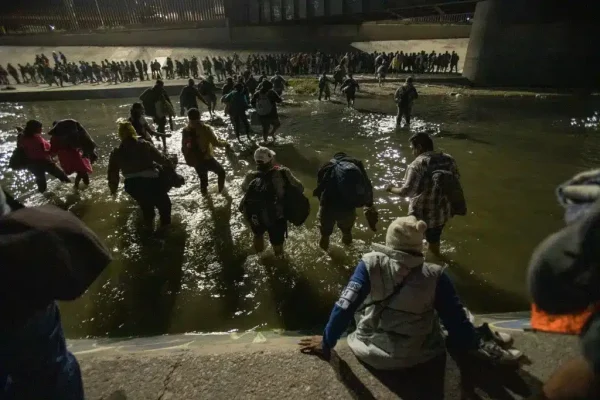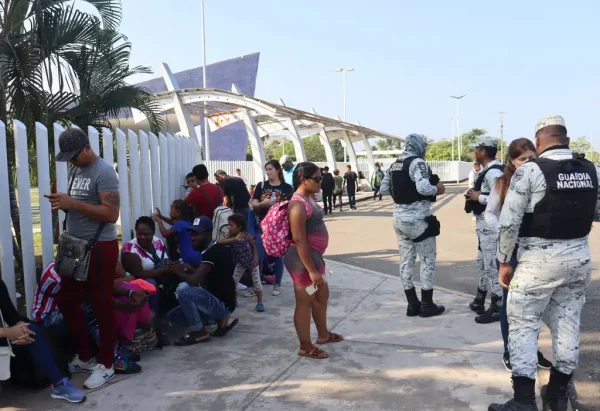Nicaraguan Migrants Falling Victim to Mexican Mafias

Experts offer advice to migrating Nicas on how to avoid becoming victims of ransom attempts, and what families should do if this occurs.
HAVANA TIMES – The December 5th rescue of 253 migrants – 186 of them Nicaraguans – from a house in Durango, Mexico, is an example of the uptick in kidnappings that began in mid-November along the routes commonly used to cross Mexico towards the US border. The most frequent large scale victims have been Nicaraguans, warn some of the non-governmental organizations that assist migrants.
On Sunday, December 11, over 1,500 migrants turned themselves in to U.S. authorities in one of the largest crossings ever through El Paso Texas. Hundreds of them were Nicaraguans who had been kidnapped and held for ransom by organized cartels.
According to the organization Texas Nicaraguan Community (TNC), the increase in the kidnappings of Nicaraguans could be related to the social media posts shared by family members of kidnapped migrants, seeking support from anywhere to raise the [ransom] money.
“The criminal groups have found a niche, a piggybank where they can get money, because the Nicas begin posting [on social media] and are going to raise the money [to pay the kidnappers] however they can,” TNC highlights.
The latest twist has been the massive kidnappings like in Durango. A member of the TNC board commented that the National Search Commission has received reports of 38 Nicaraguan migrants who’ve been kidnapped but specified that there’s a large sub-registry of families, since many prefer to pay the ransom and not denounce it.
“There’s fear, because the intimidation is very strong. As a result, there are many cases where they don’t dare even report what’s happening,” the TNC member stated.
The places in Mexico where kidnappings are reported most frequently are: Oaxaca, in the south; Ciudad Juarez on the northern border; and Veracruz in the central east coast.
Despite the risks of travel through Mexico, thousands of Nicaraguans leave every day on “excursions” to Guatemala. That’s where their road begins with the Mexican traffickers popularly known as “coyotes”, although they demand to be called “guides.” They’re the ones who will lead the migrants on the trip to the US border. The Nicaraguans, like so many others, are impelled to emigrate due to the worsening economic crisis, hunger, and the intensification of the de facto police state maintained by the regime of Daniel Ortega and Rosario Murillo.
Together, Nicaraguans, Cubans and Venezuelans have spearheaded a record number of migrants crossing over into the U.S. in 2022. The fiscal year closed with 2.7 million apprehensions by the US Customs and Border Patrol Agency.
Between January and October, 147,277 Nicaraguans were detained by US Border Patrols, far exceeding the 87,749 Nicaraguans that turned themselves in to the authorities in 2021.
Given this context, the NGOs reiterate all the dangers these migrants face, including kidnapping, and as a result, they don’t recommend this type of movement. However, they caution, once a person makes the decision to leave their country in an unauthorized way, they should consider taking certain measures in order to minimize the risk of getting kidnapped and be able to arrive at the border safely. They also recommend some measures that families should adopt.
Basic recommendations for migrants in transit towards the US
- Maintain communication with your family, preferably by sharing your real-time location. To avoid depleting your cellphone battery, you should do this at determined intervals (once an hour is recommended). This should also be done anytime you feel endangered.
- Be aware of your surroundings during the trip. It’s advisable to take photos of vehicles, bus tickets, bus license plates, highway signs and share them with a family member. Once shared, they should be deleted. That way, if something unexpected happens – be it a kidnapping or simply going missing – there are some clues for initiating a search.
- Discretion is of the utmost importance. The migrant should avoid referring to the economic conditions of his relatives in Nicaragua or the United States. Such information can be utilized by organized crime to target them as a potential kidnap victim, presuming that their family could pay for their release.
- Groups are infiltrated: The Coyotes themselves collect information from the migrants. One of them may pass as one more migrant in the group and create ties of trust with people to find out more about their life and their economic conditions.
“You shouldn’t forget that the ‘Coyote’ is first and foremost a smuggler. If they can get more out of you than the $3,500 or so you paid, they will. The Coyote is part of a criminal group and may even make it seem like he was kidnapped too,” the TNC warns.
The organization warns that many families expose themselves to additional extorsion by posting on their social media sites the disappearance of their relative, or by reporting the case to a fraudulent page that is set up to gather information. It’s probable that such a person will then receive a call from someone, informing them they’re holding their relative for ransom, although in reality the missing person could be in the hands of Mexican immigration authorities.
How to tell a fake kidnapping from a real one?
- The family should select one person who can manage the situation, since the kidnapper will send them videos related to tortures in order to intimidate the family. “They prepare you psychologically, so you go into shock.”
- The first step is to ask the abductor to provide proof of life of your relative and tell them that until you get it you can’t continue the conversation.
- If there’s no proof of life, it’s a fake.
- Family members shouldn’t accept photographs that could be edited, or a video or audio with a distorted voice. If it’s a true kidnapping, the person in charge will want the family to know that it’s real, so they’ll start working on obtaining the ransom money. Hence, they’ll make a video call with the victim, so that the relative can talk to them and confirm that it’s an authentic kidnapping.
Ronmell Lopez, a specialist in Immigration Law based in Los Angeles California, recommended that you make use of the telephone numbers of human rights organizations, such as the UN High Commissioner for Refugees (UNHCR) or the Mexican Commission for Refugee Aid, which supports immigrants and also provides legal safe conduct permits for transit through Mexican territory.
The UNHCR telephone number is +41 22 92 89 855. They’ll take the data on the missing person to check if they’re in jail, or after a certain length of time list them as kidnapped.
During this time, the human rights organizations will maintain telephone contact with the family members and provide follow-up until the person is located,” Lopez indicated.

What to do if a family member is kidnapped while migrating
- Astrid Montealegre, supervising attorney with the Nicaraguan American Human Rights Alliance (NAHRA), assured that the first thing that should be done, if the victim isn’t directly fleeing persecution by the Ortega regime, is to communicate with the Nicaraguan authorities via the Interior Ministry or the local consulate. The denunciation should be done by e-mail.
- Family members should contact the National Search Commission and provide the data requested in order to open a Missing file with the Commission. They can do so using the link: https://cnbreportadesaparecidos.segob.gob.mx/Pages/Procedimiento.aspx. They should provide the personal data of those they’re reporting missing: first and last names, gender, nationality, date and place of birth, age, education.
- Montealegre asserted that it’s important to note down the number assigned for “Search Reference” that they’ll be given once they fill out the form. The Search Commission should contact the family within 24 to 48 hours to follow up on the case.
- Denounce the case to the District Attorney’s office of the State where the family member disappeared. The institution will contact the family member in Nicaragua and later offer them the number of a prosecutor who will follow up on the case. They should give that person the information they have about the kidnapped migrant. It’s important to make the denunciation in both the District Attorney’s Office and with the Search Commission and the Nicaraguan Consulate, even though there’s some reluctance to do the latter, due to the political situation in Nicaragua.
- The organizations all recommend that family members of kidnapped migrants not post any kind of information on social networks, but always go to the authorities. Opting to manage a kidnapping case independently has disadvantages, beginning with the fact that the kidnapping has no veracity if it’s not been formally denounced. By paying out the extorsion money, what you’re doing is “strengthening organized crime,” TNC points out.
Between March and November of this year, NAHRA counted 114 Nicaraguan migrants reported missing, kidnapped or deceased. Of these, 82 people died, 14 were kidnapped and 18 are still missing.
*Article includes information from “Voces Unidas”





